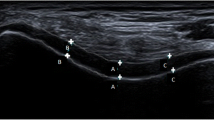Abstract
To examine the influence of intravenous steroid-treatment (IST) on serum levels of Cartilage oligomeric matrix protein (COMP) in patients with active rheumatoid arthritis (RA). Serum levels of COMP and C-reactive protein (CRP) were measured in 12 patients with highly active RA (Steinbrocker stages II–IV) and in 5 patients with highly active reactive arthritis (ReA) (positive testing for HLA-B27) before starting daily IST. Patients received a total steroid dosage between 100 and 500 mg of prednisolone. COMP was measured by a commercially available sandwich-type ELISA-kit developed by AnaMar Medical AB, Sweden. Statistical evaluation was calculated by paired t test. In the RA group, COMP levels ranged from 6.3 to 19.4 U/l (mean 12.9 U/l), CRP from 5 to 195 mg/l (mean 77.8 mg/l), the COMP levels of the ReA group ranged from 5.1 to 7.4 U/l (mean 7.9 U/l), the CRP levels from 13 to 126 mg/l (mean 49 mg/l). We found a significant difference between the initial COMP levels in RA+ and ReA patients (P<0.005). In contrast to the ReA group, serum-COMP levels of RA+ patients (P<0.004) and the VAS (P<0.0001) decreased significantly within 2–10 days after the first treatment with steroids. The CRP levels remained unchanged in both groups. Our results indicate that the intravenous treatment with steroids in patients with highly active RA leads to a significant decrease of cartilage degradation. COMP seems to be a valuable parameter not even as a prognostic factor, but as a marker for monitoring the therapy response in patients with RA.






Similar content being viewed by others
References
Haynes DR, Barg E, Crotti TN, Holding C, Weedon H, et al (2003) Osteoprotegerin expression in synovial tissue from patients with rheumatoid arthritis, spondylarthropathies and osteoarthritis and normal controls. Rheumatology 42:123–134
Skoumal M, Kolarz G, Woloszczuk W, Hawa G, Klingler A (2004) Serumosteoprotegerin but not receptor activator of NF-Kappa B ligand correlates with the Larsen score in rheumatoid arthritis. Ann Rheum Dis 63/2:216–217
Oldberg A, Antonsson P, Lindblom K, Heinegaard D (1992) COMP (cartilage oligomeric matrix protein) is structurally related to the thrombospondins. J Biol Chem 267:22346–22350
Marti C, Neidhart M, Gerber T, Hauser N, Michel BA, Häuselmann HJ (1999) Cartilage Oligomeric Matrix Protein (COMP): Die Rolle eines nichtkollagenen Knorpel-Matrix-Proteins als Marker der Krankheitsaktivität und Gelenkszerstörung bei Patienten mit rheumatoider Arthritis und Arthrose. Z Rheumatol 58:79–87
Neidhart M, Hauser N, Paulsson M, DiCesare PE, Michel BA, Häuselmann HJ (1997) Small fragments of cartilage oligomatrix protein in synovial fluid and serum as markers for cartilage degradation. Brit J Rheumatol 36:1151–1160
Crnkic M, Mansson B, Larsson L, Geborek P, Heinegard D, Saxne T (2003) Serum cartilage oligomeric matrix protein (COMP) decreases in rheumatoid arthritis patients treated with infliximab or etanercept. Arthritis Res Ther 5(4):181–185
Skoumal M, Kolarz G, Klingler A. (2003) Serum levels of cartilage oligomeric matrix protein (COMP): a predicting factor and a valuable parameter for disease management in rheumatoid arthritis. Scand J Rheumatol 32:156–161
Forslind K, Eberhardt K, Jonsson A, Saxne T (1992) Increased serum concentrations of cartilage oligomeric matrix protein. A prognostic marker in early rheumatoid arthritis. Brit J Rheumatol 31:593–598
Mansson B, Gülfe A, Geborek P, Heinegard D, Saxne T (2001) Release of cartilage and bone macromolecules into synovial fluid: differences between psoriatic arthritis and rheumatoid arthritis. Ann Rheum Dis 60:27–31
Lindquist E, Eberhardt K, Bendtzen K, Heinegard D, Saxne T (2005) Prognostic laboratory markers of joint damage in rheumatoid arthritis. Ann Rheum Dis 64:196–201
Author information
Authors and Affiliations
Corresponding author
Rights and permissions
About this article
Cite this article
Skoumal, M., Haberhauer, G., Feyertag, J. et al. Serum levels of cartilage oligomeric matrix protein (COMP): a rapid decrease in patients with active rheumatoid arthritis undergoing intravenous steroid treatment. Rheumatol Int 26, 1001–1004 (2006). https://doi.org/10.1007/s00296-006-0117-4
Received:
Accepted:
Published:
Issue Date:
DOI: https://doi.org/10.1007/s00296-006-0117-4




